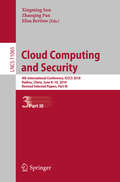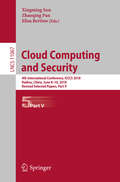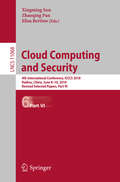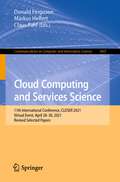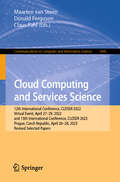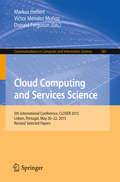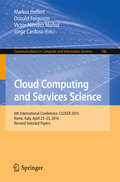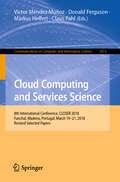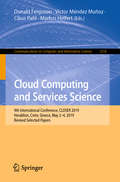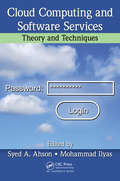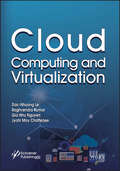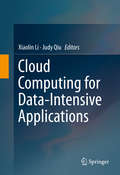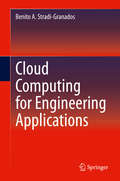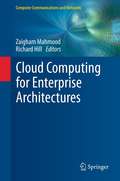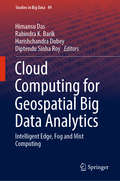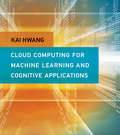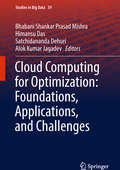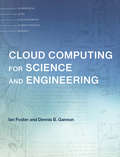- Table View
- List View
Cloud Computing and Security: Third International Conference, Icccs 2017, Nanjing, China, June 16-18, 2017, Revised Selected Papers, Part Ii (Lecture Notes in Computer Science #10603)
by Elisa Bertino Xingming Sun Zhaoqing PanThis six volume set LNCS 11063 – 11068 constitutes the thoroughly refereed conference proceedings of the 4th International Conference on Cloud Computing and Security, ICCCS 2018, held in Haikou, China, in June 2018. The 386 full papers of these six volumes were carefully reviewed and selected from 1743 submissions. The papers cover ideas and achievements in the theory and practice of all areas of inventive systems which includes control, artificial intelligence, automation systems, computing systems, electrical and informative systems. The six volumes are arranged according to the subject areas as follows: cloud computing, cloud security, encryption, information hiding, IoT security, multimedia forensics.
Cloud Computing and Security: Third International Conference, Icccs 2017, Nanjing, China, June 16-18, 2017, Revised Selected Papers, Part Ii (Lecture Notes in Computer Science #10603)
by Elisa Bertino Xingming Sun Zhaoqing PanThis six volume set LNCS 11063 – 11068 constitutes the thoroughly refereed conference proceedings of the 4th International Conference on Cloud Computing and Security, ICCCS 2018, held in Haikou, China, in June 2018. The 386 full papers of these six volumes were carefully reviewed and selected from 1743 submissions. The papers cover ideas and achievements in the theory and practice of all areas of inventive systems which includes control, artificial intelligence, automation systems, computing systems, electrical and informative systems. The six volumes are arranged according to the subject areas as follows: cloud computing, cloud security, encryption, information hiding, IoT security, multimedia forensics
Cloud Computing and Security: Third International Conference, Icccs 2017, Nanjing, China, June 16-18, 2017, Revised Selected Papers, Part Ii (Lecture Notes in Computer Science #10603)
by Elisa Bertino Xingming Sun Zhaoqing PanThis six volume set LNCS 11063 – 11068 constitutes the thoroughly refereed conference proceedings of the 4th International Conference on Cloud Computing and Security, ICCCS 2018, held in Haikou, China, in June 2018. The 386 full papers of these six volumes were carefully reviewed and selected from 1743 submissions. The papers cover ideas and achievements in the theory and practice of all areas of inventive systems which includes control, artificial intelligence, automation systems, computing systems, electrical and informative systems. The six volumes are arranged according to the subject areas as follows: cloud computing, cloud security, encryption, information hiding, IoT security, multimedia forensics
Cloud Computing and Security: Third International Conference, Icccs 2017, Nanjing, China, June 16-18, 2017, Revised Selected Papers, Part Ii (Lecture Notes in Computer Science #10603)
by Elisa Bertino Xingming Sun Zhaoqing PanThis six volume set LNCS 11063 – 11068 constitutes the thoroughly refereed conference proceedings of the 4th International Conference on Cloud Computing and Security, ICCCS 2018, held in Haikou, China, in June 2018. The 386 full papers of these six volumes were carefully reviewed and selected from 1743 submissions. The papers cover ideas and achievements in the theory and practice of all areas of inventive systems which includes control, artificial intelligence, automation systems, computing systems, electrical and informative systems. The six volumes are arranged according to the subject areas as follows: cloud computing, cloud security, encryption, information hiding, IoT security, multimedia forensics
Cloud Computing and Service Science: 7th International Conference, CLOSER 2017, Porto, Portugal, April 24–26, 2017, Revised Selected Papers (Communications in Computer and Information Science #864)
by Markus Helfert Donald Ferguson Jorge Cardoso Víctor Méndez Muñoz Claus PahlThis book constitutes extended, revised and selected papers from the 7th Ith International Conference on Cloud Computing and Service Science, CLOSER 2017, held in Porto, Portugal, in April 2017. The 16 papers presented in this volume were carefully reviewed and selected from a total of 123 submissions. CLOSER 2017 focused on the emerging area of Cloud Computing, inspired by some latest advances that concern the infrastructure, operations and available services throughout the global network.
Cloud Computing and Services Science: 10th International Conference, CLOSER 2020, Prague, Czech Republic, May 7–9, 2020, Revised Selected Papers (Communications in Computer and Information Science #1399)
by Markus Helfert Donald Ferguson Claus PahlThis book constitutes extended, revised and selected papers from the 10th International Conference on Cloud Computing and Services Science, CLOSER 2020, held in Prague, Czech Republic, in May 2020. Due to the COVID-19 pandemic the conference was held in a virtual format.The 14 papers presented in this volume were carefully reviewed and selected from a total of 69 submissions. CLOSER 2020 focuses on the emerging area of cloud computing, inspired by some latest advances that concern the infrastructure, operations, and available servicesthrough the global network.
Cloud Computing and Services Science: 11th International Conference, CLOSER 2021, Virtual Event, April 28–30, 2021, Revised Selected Papers (Communications in Computer and Information Science #1607)
by Markus Helfert Donald Ferguson Claus PahlThis book constitutes the refereed proceedings of the 11th International Conference on Cloud Computing and Services Science, CLOSER 2021, Virtual Event, during April 28–30, 2021. The 5 full papers included in this book were carefully reviewed and selected from 51 submissions. The proceedings deal with the topics of data processing, cloud computing environments, and services science.
Cloud Computing and Services Science: 12th International Conference, CLOSER 2022, Virtual Event, April 27–29, 2022, and 13th International Conference, CLOSER 2023, Prague, Czech Republic, April 26–28, 2023, Revised Selected Papers (Communications in Computer and Information Science #1845)
by Donald Ferguson Maarten Van Steen Claus PahlThis book constitutes revised selected papers from the 12th and 13th International Conference on Cloud Computing and Services Science , CLOSER 2022 and CLOSER 2023, which took place as a virtual event in April 2022 and in Prague, Czech Republic, in April 2023. CLOSER 2022 received a total of 45 submissions out of which 3 papers are included in this book. From 46 submissions received for CLOSER 2023, 7 papers have been selected for inclusion in this book. They focus on latest advances and various aspects of cloud computing and the link to services science.
Cloud Computing and Services Science: 5th International Conference, CLOSER 2015, Lisbon, Portugal, May 20-22, 2015, Revised Selected Papers (Communications in Computer and Information Science #581)
by Markus Helfert Donald Ferguson Víctor Méndez MuñozThis book constitutes the thoroughly refereed proceedings of the 5th International Conference on Cloud Computing and Services Science, CLOSER 2015, held in Lisbon, Portugal, in May 2015. The 14 revised full papers presented together with one invited paper were selected from 146 paper submissions. The papers focus on the following topics: cloud computing fundamentals; services science foundations for cloud computing; cloud computing platforms and applications; cloud computing enabling technologies; and mobile cloud computing services.
Cloud Computing and Services Science: 6th International Conference, CLOSER 2016, Rome, Italy, April 23-25, 2016, Revised Selected Papers (Communications in Computer and Information Science #740)
by Markus Helfert Donald Ferguson Jorge Cardoso Victor Méndez MuñozNormal 0 false false false EN-US X-NONE X-NONE MicrosoftInternetExplorer4 This book constitutes the thoroughly refereed proceedings of the 4th International Conference on Cloud Computing and Services Science, CLOSER 2014, held in Barcelona, Spain, in April 2014. The 14 papers presented were selected from 127 paper submissions. The papers focus on the following topics: cloud computing fundamentals; services science foundations for cloud computing; cloud computing platforms and applications; cloud computing enabling technologies; and mobile cloud computing services. /* Style Definitions */ table. MsoNormalTable {{mso-style-name:"Table Normal"; mso-tstyle-rowband-size:0; mso-tstyle-colband-size:0; mso-style-noshow:yes; mso-style-priority:99; mso-style-qformat:yes; mso-style-parent:""; mso-padding-alt:0in 5. 4pt 0in 5. 4pt; mso-para-margin:0in; mso-para-margin-bottom:. 0001pt; mso-pagination:widow-orphan; font-size:11. 0pt; font-family:"Calibri","sans-serif"; mso-ascii-font-family:Calibri; mso-ascii-theme-font:minor-latin; mso-fareast-font-family:"Times New Roman"; mso-fareast-theme-font:minor-fareast; mso-hansi-font-family:Calibri; mso-hansi-theme-font:minor-latin; mso-bidi-font-family:"Times New Roman"; mso-bidi-theme-font:minor-bidi;}} ntStyles> e"/>
Cloud Computing and Services Science: 8th International Conference, CLOSER 2018, Funchal, Madeira, Portugal, March 19-21, 2018, Revised Selected Papers (Communications in Computer and Information Science #1073)
by Markus Helfert Donald Ferguson Víctor Méndez Muñoz Claus PahlThis book constitutes extended, revised and selected papers from the 8th International Conference on Cloud Computing and Services Science, CLOSER 2018, held in Funchal, Portugal in March 2018. The 11 papers presented in this volume were carefully reviewed and selected from a total of 94 submissions. CLOSER 2018 focused on the emerging area of Cloud Computing, inspired by some latest advances that concern the infrastructure, operations and available services throughout the global network.
Cloud Computing and Services Science: 9th International Conference, CLOSER 2019, Heraklion, Crete, Greece, May 2–4, 2019, Revised Selected Papers (Communications in Computer and Information Science #1218)
by Markus Helfert Donald Ferguson Víctor Méndez Muñoz Claus PahlThis book constitutes extended, revised and selected papers from the 9th International Conference on Cloud Computing and Services Science, CLOSER 2019, held in Heraklion, Greece, in May 2019.The 11 papers presented in this volume were carefully reviewed and selected from a total of 102 submissions. CLOSER 2019 focuses on the emerging area of Cloud Computing, inspired by some latest advances that concern the infrastructure, operations, and available servicesthrough the global network.
Cloud Computing and Services Science: Third International Conference, CLOSER 2013, Aachen, Germany, May 8-10, 2013, Revised Selected Papers (Communications in Computer and Information Science #453)
by Markus Helfert, Frédéric Desprez, Donald Ferguson and Frank LeymannThis book constitutes the thoroughly refereed proceedings of the Third International Conference on Cloud Computing and Services Science, CLOSER 2013, held in Aachen, Germany, in May 2013. The 8 papers presented were selected from 142 paper submissions. The papers cover the following topics: cloud computing fundamentals; services science foundations for cloud computing; cloud computing platforms and applications; and cloud computing enabling technologies.
Cloud Computing and Services Sciences: International Conference in Cloud Computing and Services Sciences, CLOSER 2014 Barcelona Spain, April 3–5, 2014 Revised Selected Papers (Communications in Computer and Information Science #512)
by Markus Helfert Frédéric Desprez Donald Ferguson Frank Leymann Víctor Méndez MuñozThis book constitutes the thoroughly refereed proceedings of the 4th International Conference on Cloud Computing and Services Science, CLOSER 2014, held in Barcelona, Spain, in April 2014. The 14 papers presented were selected from 127 paper submissions. The papers focus on the following topics: cloud computing fundamentals; services science foundations for cloud computing; cloud computing platforms and applications; cloud computing enabling technologies; and mobile cloud computing services.
Cloud Computing and Software Services: Theory and Techniques
by Mohammad Ilyas Syed A. AhsonWhether you're already in the cloud, or determining whether or not it makes sense for your organization, Cloud Computing and Software Services: Theory and Techniques provides the technical understanding needed to develop and maintain state-of-the-art cloud computing and software services. From basic concepts and recent research findings to fut
Cloud Computing and Virtualization
by Dac-Nhuong Le Raghvendra Kumar Nguyen Gia Nhu Jyotir Moy ChatterjeeThe purpose of this book is first to study cloud computing concepts, security concern in clouds and data centers, live migration and its importance for cloud computing, the role of firewalls in domains with particular focus on virtual machine (VM) migration and its security concerns. The book then tackles design, implementation of the frameworks and prepares test-beds for testing and evaluating VM migration procedures as well as firewall rule migration. The book demonstrates how cloud computing can produce an effective way of network management, especially from a security perspective.
Cloud Computing for Data-Intensive Applications
by Xiaolin Li Judy QiuThis book presents a range of cloud computing platforms for data-intensive scientific applications. It covers systems that deliver infrastructure as a service, including: HPC as a service; virtual networks as a service; scalable and reliable storage; algorithms that manage vast cloud resources and applications runtime; and programming models that enable pragmatic programming and implementation toolkits for eScience applications. Many scientific applications in clouds are also introduced, such as bioinformatics, biology, weather forecasting and social networks. Most chapters include case studies. Cloud Computing for Data-Intensive Applications targets advanced-level students and researchers studying computer science and electrical engineering. Professionals working in cloud computing, networks, databases and more will also find this book useful as a reference.
Cloud Computing for Engineering Applications
by Benito A. Stradi-GranadosThis book explains the use of cloud computing systems for engineering applications to satisfy the need for enterprise level, state-of-the-art computational capacities at an affordable cost. As huge costs are involved in the maintenance and timely renovation of computational capabilities, particularly for projects that require significant computational capacity, cloud services can achieve considerable savings for users and organizations engaged in engineering research and development. Dr. Stradi-Granados explains how to extract a maximum value from every dollar invested in cloud computer server. The types of facilities located around the world that lease their resources to customers interested in reducing the internal overhead and implementation time. The volume features chapters on model generation, motion studies, and prototyping is ideal for students, researchers, practitioners, and facility's managers across a range of engineering domains.
Cloud Computing for Enterprise Architectures (Computer Communications and Networks)
by Zaigham Mahmood Richard HillThis important text provides a single point of reference for state-of-the-art cloud computing design and implementation techniques. The book examines cloud computing from the perspective of enterprise architecture, asking the question; how do we realize new business potential with our existing enterprises? Topics and features: with a Foreword by Thomas Erl; contains contributions from an international selection of preeminent experts; presents the state-of-the-art in enterprise architecture approaches with respect to cloud computing models, frameworks, technologies, and applications; discusses potential research directions, and technologies to facilitate the realization of emerging business models through enterprise architecture approaches; provides relevant theoretical frameworks, and the latest empirical research findings.
Cloud Computing for Geospatial Big Data Analytics: Intelligent Edge, Fog And Mist Computing (Studies in Big Data #49)
by Himansu Das Rabindra K. Barik Harishchandra Dubey Diptendu Sinha RoyThis book introduces the latest research findings in cloud, edge, fog, and mist computing and their applications in various fields using geospatial data. It solves a number of problems of cloud computing and big data, such as scheduling, security issues using different techniques, which researchers from industry and academia have been attempting to solve in virtual environments. Some of these problems are of an intractable nature and so efficient technologies like fog, edge and mist computing play an important role in addressing these issues. By exploring emerging advances in cloud computing and big data analytics and their engineering applications, the book enables researchers to understand the mechanisms needed to implement cloud, edge, fog, and mist computing in their own endeavours, and motivates them to examine their own research findings and developments.
Cloud Computing for Lawyers
by Nicole Black Richard SusskindAs more businesses move their IT systems into the cloud, lawyers need to ask if cloud computing is right for their firm. Cloud Computing for Lawyers features a discussion of cloud computing fundamentals, an overview of legal cloud computing products, and step-by-step instructions for implementing cloud computing in your practice--including practical tips for securing your data.
Cloud Computing for Machine Learning and Cognitive Applications
by Kai HwangThe first textbook to teach students how to build data analytic solutions on large data sets using cloud-based technologies. This is the first textbook to teach students how to build data analytic solutions on large data sets (specifically in Internet of Things applications) using cloud-based technologies for data storage, transmission and mashup, and AI techniques to analyze this data. This textbook is designed to train college students to master modern cloud computing systems in operating principles, architecture design, machine learning algorithms, programming models and software tools for big data mining, analytics, and cognitive applications. The book will be suitable for use in one-semester computer science or electrical engineering courses on cloud computing, machine learning, cloud programming, cognitive computing, or big data science. The book will also be very useful as a reference for professionals who want to work in cloud computing and data science.Cloud and Cognitive Computing begins with two introductory chapters on fundamentals of cloud computing, data science, and adaptive computing that lay the foundation for the rest of the book. Subsequent chapters cover topics including cloud architecture, mashup services, virtual machines, Docker containers, mobile clouds, IoT and AI, inter-cloud mashups, and cloud performance and benchmarks, with a focus on Google's Brain Project, DeepMind, and X-Lab programs, IBKai HwangM SyNapse, Bluemix programs, cognitive initiatives, and neurocomputers. The book then covers machine learning algorithms and cloud programming software tools and application development, applying the tools in machine learning, social media, deep learning, and cognitive applications. All cloud systems are illustrated with big data and cognitive application examples.
Cloud Computing for Optimization: Foundations, Applications, and Challenges (Studies in Big Data #39)
by Bhabani Shankar Prasad Mishra Satchidananda Dehuri Alok Kumar Jagadev Himansu DasThis book discusses harnessing the real power of cloud computing in optimization problems, presenting state-of-the-art computing paradigms, advances in applications, and challenges concerning both the theories and applications of cloud computing in optimization with a focus on diverse fields like the Internet of Things, fog-assisted cloud computing, and big data. In real life, many problems – ranging from social science to engineering sciences – can be identified as complex optimization problems. Very often these are intractable, and as a result researchers from industry as well as the academic community are concentrating their efforts on developing methods of addressing them. Further, the cloud computing paradigm plays a vital role in many areas of interest, like resource allocation, scheduling, energy management, virtualization, and security, and these areas are intertwined with many optimization problems. Using illustrations and figures, this book offers students and researchers a clear overview of the concepts and practices of cloud computing and its use in numerous complex optimization problems.
Cloud Computing for Science and Engineering (Scientific and Engineering Computation)
by Ian Foster Dennis B. GannonA guide to cloud computing for students, scientists, and engineers, with advice and many hands-on examples.The emergence of powerful, always-on cloud utilities has transformed how consumers interact with information technology, enabling video streaming, intelligent personal assistants, and the sharing of content. Businesses, too, have benefited from the cloud, outsourcing much of their information technology to cloud services. Science, however, has not fully exploited the advantages of the cloud. Could scientific discovery be accelerated if mundane chores were automated and outsourced to the cloud? Leading computer scientists Ian Foster and Dennis Gannon argue that it can, and in this book offer a guide to cloud computing for students, scientists, and engineers, with advice and many hands-on examples. The book surveys the technology that underpins the cloud, new approaches to technical problems enabled by the cloud, and the concepts required to integrate cloud services into scientific work. It covers managing data in the cloud, and how to program these services; computing in the cloud, from deploying single virtual machines or containers to supporting basic interactive science experiments to gathering clusters of machines to do data analytics; using the cloud as a platform for automating analysis procedures, machine learning, and analyzing streaming data; building your own cloud with open source software; and cloud security.The book is accompanied by a website, Cloud4SciEng.org, that provides a variety of supplementary material, including exercises, lecture slides, and other resources helpful to readers and instructors.
Cloud Computing for Smart Education and Collaborative Learning
by Urmila Shrawankar Prerna MishraThe book presents next-generation education technology and the pedagogy of the Education Cloud. It covers technological developments, case studies, innovative research approaches, and solutions for advanced learning paradigms using Internet of Things (IoT), cloud computing, and machine learning to handle various challenges of the smart education system. It discusses cloud architecture, management, and frame- work for education from virtual classrooms and labs. It shows how cloud computing framework can be integrated with fog computing, edge computing, deep learning, and IoT. Illustrates from fundamental theories to practical and sophisticated applications of cloud technology for the education domain Explores e-learning applications through location-independent cloud services to reduce cost Covers result-oriented, real-time solutions for smart, accessible education and its real-time application support Discusses accessible cloud services for people with special needs Presents flexible and scalable cost-effective e-learning architecture and scenario for education technology It serves as a valuable resource for academicians, researchers, and professionals interested in smart education and cloud technology.
